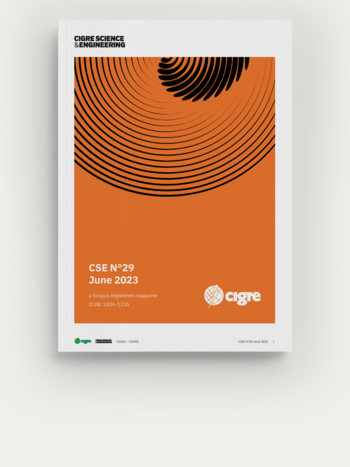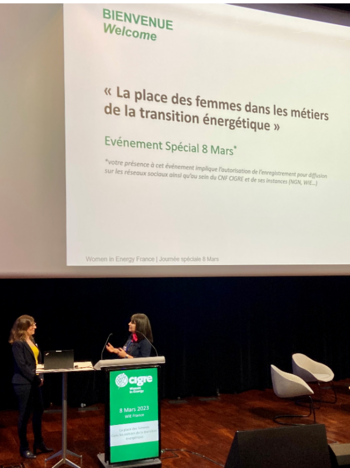CIGRE GCC – Report of the 2023 Oman Symposium

Muscat - Oman
6-8 March 2023
by the Technical Organizing Committee:
N. Uzelac, Chair SC A3, P. Van Dyke, Chair SC B2, J. Hu, Chair SC B4 and K. Dedekind, Chair SC C6 together with the GCC CIGRE Chair: Ahmed Nasser M. Al Naser
Introduction
The GCC CIGRE National Committee working with 4 CIGRE Study Committees (A3, B2, B4 and C6) hosted the CIGRE Muscat 2023 Symposium in Oman from 06 to 08 March 2023. This Symposium, with the theme “transition to innovative, sustainable and resilient power systems”, covered important issues the power system industry is facing at present. The technology advances in the Gulf region were of particular interest, where projects and challenges relating to the energy transition were highlighted. It also accentuated the fact that CIGRE is indeed moving to become an end to end (E2E) association covering the full spectrum from power generation, to having to deal with the customer interface.
During the three-day Symposium, 473 participants from 25 countries met, and where 47 papers from countries were presented in 8 oral sessions. Four Tutorials together with a short course on Overhead Lines concluded the technical content of the Symposium. Additionally, four papers from the GCC were shared in an NGN forum that formed part of the Symposium proceedings.
A wide range of topics were discussed during the Symposium, such as sustainable and resilient power systems, digital networks, integration of information technologies, which allowed attendees to share the latest research findings and operational experiences, and, to address recent technical advances and policy developments that allow transmission and distribution networks to enter their next era.
The Symposium was technically supported by Study Committees A3, B2, B4 and C6 with support from several other Study Committee’s. The Symposium was locally organised by the CIGRE GCC Organising Committee and was supported by the Nama Holding Committee, the Oman Electricity Transmission Company, The GCC Interconnection Authority, together with several sponsors with an interest in the Gulf Region
Symposium Programme
The Symposium venue was in Muscat at The Oman Convention and Exhibition Centre. The Technical Organising Committee, comprising CIGRE, The CIGRE GCC National Committee and the local Oman Organising Committee hosted the event. The program for the three-day event looked as follows.
Day 1 – 06 March 2023 | ||
09h00 | Inauguration Ceremony |
|
10h00 | NGN Presentation |
|
11h00 | Short Course – High Voltage Overhead lines (Prof K Papailiou) |
|
15h30 | Close of Day 1 |
|
18h30 | Reception Dinner |
|
Day 2 – 07 March 2023 | ||
08h30 | Tutorial 1 | Tutorial 2 |
10h00 | Women in Energy Discussion |
|
11h30 | Session A1 - Cable and Overhead lines | Session B1 – Technology applications and trends |
13h30 | Session A2 – HVDC applications | Session B2 – Managing DER integration |
15h00 | Close of Day 2 |
|
Day 3 – 08 March 2023 | ||
08h30 | Tutorial 3 | Tutorial 4 |
10h30 | Session A3 – HVDC Convertors and Network Characteristics | Session B3 – Managing DER integration |
12h30 | Session A4 – Transformer characteristics and Data management | Session B4 – Network operations management |
14h00 | Closing ceremony |
|
15h00 | Close of Day 3 |
|
An inauguration ceremony was held at the Oman Conference and Exhibition Centre with welcome speeches from the Oman Board member of the CIGRE GCC, the Chair of the CIGRE GCC National Committee and by the Secretary General of CIGRE.

Dignitaries at the Opening Ceremony of the Muscat Symposium
8 oral sessions, with a wide variety of papers were presented with dynamic and intensive discussions. The B4 and C6 related presentations were able to be hosted in sessions that exclusively dealt with their respective Study Committee Scopes of Work. All other sessions were hybrid in nature and presentations representing multiple Study Committee topics were shared at the Symposium. Four Tutorials were hosted from each of the participating Study Committee’s at the Symposium. Closing remarks were given with an address from each SC Chair summarizing the salient findings and learning points.
The symposium focused on new research, developments and policies related to the transition to innovative, sustainable, and resilient power systems. The preferential subjects for the symposium revolved around the following:
- PS1: Driving towards an enhanced system Sustainability, and Resiliency with increasing shares of Renewables
- PS2: Innovations in Future Power Grids in Energy Storage, Electric Vehicles & Digitalization
- PS3: Development in HVDC Grids and Multi-terminal HVDC
NGN Session
Following the Opening Ceremony of the Symposium, a set of presentations were hosted by the NGN delegated from the Gulf Region. They shared some innovative experiences and challenges regarding the integration of renewable energy in this area. The following pertinent points were raised as an outcome of the NGN and WiE sessions during the symposium….
- Establishing a GCC NGN Group to attract and involve early professionals and students in CIGRE activities.
- Encouraging students to consider joining the power system industry which has job opportunities related to the energy transition.
- Addressing the age and gender gaps in the energy sector which will require implementing policies to create a more inclusive environment.
The short course on HV Overhead Lines followed the NGN session and was very actively supported by many of the delegates.

Prof Konstantin Papailiou hosting the Short Course on Overhead Lines
Women in Energy (WiE) session
A Women in Energy (WiE) panel was chaired by Dr. Abeer Al-Maimouni, Assistant professor, from College of Engineering and petroleum at the Kuwait University. There were three guest speakers, Ms. Najla Al Jamali from Alternative Energy - OQ, Eng. Ahlam Al-Kindi from Oman Electricity Transmission Company and Eng. Joanne Hu from RBJ Engineering. The panel spoke about their experiences and thoughts as women engineers that work in male-dominant environment. Elements such as challenges facing women engineers, factors affecting the climb of the career ladder, current perspectives, and scenarios (present and future), and the creation of a more female-friendly environment were discussed as suggestions to young female engineers. The debate concluded that the work environment has improved for female engineers and is likely to improve further in the future to include better supportive systems, either from the company, or from family structures. Women engineers do not really need distinguish themselves from men engineers. Women engineers can be successful if they are confident and hardworking regardless of their cultural background. It requires raising the awareness among leaders to better understand the challenges women face at the workplace and design the appropriate policies to increase the retention of women in the energy sector and to create a more diverse workplace. In conjunction with the discussions at the Muscat Symposium and the WiE panel, the GCC intends to officially establish a GCC WiE group.

The Women in Energy program on Day 2 of the Muscat Symposium
The Tutorial programs
Four Tutorials were presented as part of the program. A short overview of each session is shared.
Tutorial 1: Innovations and trends in Transmission and Distribution equipment - SC A3
It was presented by Nenad Uzelac, who is a Research Director at G&W Electric Co. Global and Frank Richter from Offshore Assets, 50 Hz.
This tutorial covered trends in energy transition relevant to T&D equipment. The electrical power grid is undergoing a major transformation, and there are several trends that are driving this change. One of the key trends is the hardening of the grid. This involves making the grid more resilient and less susceptible to damage from extreme weather events, cyber-attacks, and physical attacks. This can be achieved using more reliable T&D equipment, higher ratings, faster switching operation, integration of renewables, and technologies for HVDC. Another trend is the greening of the grid. This involves the integration of renewable energy sources such as wind and solar power into the grid, which requires significant upgrades to the transmission and distribution (T&D) equipment to accommodate these intermittent energy sources. SF6 free equipment was discussed, and it was illustrated by an example from German TSO, 50 Hertz. Finally, the smartening of the grid is another major trend, which involves the use of advanced digital technologies to improve grid performance, reliability, and efficiency.
Tutorial 2: Overhead conductor motion phenomena and control methods (Aeolian vibrations and sub-span oscillations) - SC B2
It was presented by Pierre Van Dyke, who is a Senior Research Scientist at the Hydro-Quebec Research Institute.
The tutorial explained the mechanism of aeolian vibrations and sub-span oscillations on overhead line conductors. Short videos were shown to illustrate the two types of conductor vibration. The impact of both phenomena such as conductor fatigue, conductor wear due to clamp loosening, spacer damage, etc. has been covered. Conductor fatigue indicators were introduced, and experimental results were presented to explain the impact of different parameters such as wind speed and azimuth, conductor tension and bundling on vibration severity. Proven solutions have been explained to understand how to cope with both phenomena.
Tutorial 3: Guide to Develop Real-Time Simulation Models (RTSM) for HVDC Operational Studies Models (RTSM) for HVDC Operational Studies - SC B4
This tutorial was presented by Dr. Qi GUO, Vice President of Electric Power Research Institute, China Southern Power Grid (CSG), Mr. Mengjun LIAO, Senior Engineer of Electric Power Research Institute, China Southern Power Grid (CSG), Dr. Ren Liu Researcher, Electric Power Research Institute, China Southern Power Grid and Walid Ziad El-Khatib, Senior Lead Engineer, Vattenfall.
The real-time simulation has been used extensively in validating the control and protection system of HVDC and FACTS. The modelling is critical part of RTDS. This tutorial was well delivered and appreciated by the GCC and symposium participants. Many questions such as validation of real time simulation models have been raised by the audience.
Tutorial 4: Rural Electrification - SC C6
The presentation was made by Kurt Dedekind who heads up the Planning Centre of Excellence in Eskom.
The backlog of people living without access to electricity is still significant in many developing countries around the globe. Grid-tied and off-grid solutions, with a myriad of technology options associated with each of these, provide an opportunity for these countries to close the gap. The tutorial shared opportunities that provide a capability to leapfrog the development of electricity infrastructure via innovative solutions to enable electricity access to much of the population. Many of the countries also have abundant energy resources available to them, such as solar, hydro and wind, however invariably the cost of creating the associated assets, and operating and maintaining them in the remote rural communities, remains a challenge.
Optimal technical solutions, accompanied by stable political, regulatory and market platforms, provide the essential mix to facilitate the rollout of rural electrification programs across the globe. The tutorial explored the integration of how growing shares of renewable energy sources will also contribute to the overall reduction of carbon emissions, whilst expanding the rural electrification footprint in the world.
Technical Exhibition
The technical exhibition involving 10 exhibitors, formed the hub of the conference and provided an excellent opportunity for delegates to interact with industry and to familiarize themselves with their latest advances and innovations.
Key learning points from the Muscat Symposium
The following sections provide key learning points per Study Committee.
Study Committee A3 and D1 (Transmission and Distribution equipment and Materials and Emerging Test techniques)
CIGRE Study Committee (SC) A3 is responsible for Transmission and Insulation equipment, and SC D1 for Technology enablers. During Session B1 we had 6 papers prepared. 3 papers were presented in person, 2 over recordings and one paper was not presented.
Out of 6 papers, 4 papers were under “Driving towards an enhanced system Sustainability, and Resiliency with increasing shares of Renewables” and 2 papers under “Development in HVDC Grids and Multi-terminal HVDC”. The highlights of the session were:
Several different technologies are being utilized to support the energy transition.
Transmission and Distribution equipment: computer simulation tools are being developed and validated to speed up the development of ultra-fast 800kV HVDC switch. Without these simulation tools, the design cycle of the equipment would be much longer. Also, different types of software tools are being used to calculate the carbon footprint of equipment. This is an important step to help making educated purchasing.
Material science: properties of different materials are evaluated after being subjected to accelerated aging testing. Better understanding of aging and failure mechanisms will help improving the product designs and making it more suitable for harsh weather conditions.
Machine learning (ML): Machine learning is getting more traction in the power industry. In this session, the case study of using ML for condition assessment of PV farms was presented.
Installed T&D equipment is aging, and new equipment is getting more complex (adding sensors, higher ratings, etc.) and accordingly we need to keep an eye on reliability of equipment. To improve the resilience of the grid, we need more, not less reliable equipment.
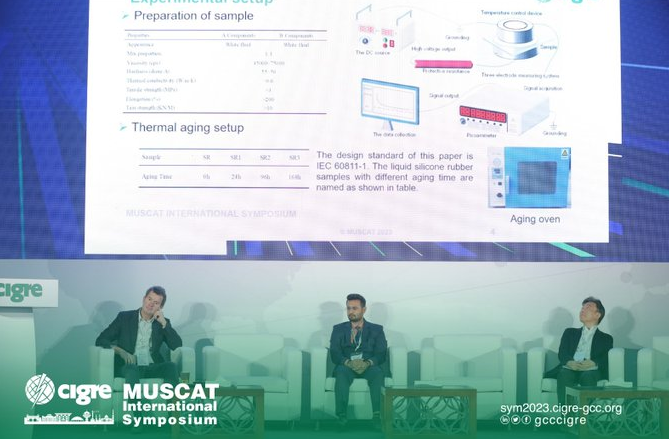
A presentation in progress during session B1
Study Committee B1 and B2 (Insulated Cables and Overhead Lines)
CIGRE Study Committee (SC) B1 is responsible for insulated cables, and SC B2 for Overhead Lines.
A total of 6 papers were accepted for the 2023 Muscat Symposium. A recording of Paper A103 was presented, and all other presentations were presented in Muscat. The papers all addressed the preferential subject PS-1:
PS1: Driving towards an enhanced system sustainability and resiliency with increasing shares of Renewables
The highlights of the session were:
- SC B1 papers:
- The increase in wind and solar energy has led to a demand for cables that can withstand harsh conditions such as high temperatures, UV, atmospheric ozone, and fire hazards. An accelerated test based on mechanical properties is proposed to determine their service life.
- Development of a polymeric termination for Mass Impregnated Non-Drained (MIND) cables.
- SC B2 papers:
- Conductor replacement method to address the continuous increase in power demand.
The lack of technical documentation of the existing line can be solved. - Surface coating to be applied on conductor to reduce their absorptivity and increase their emissivity has been discussed.
- Variations in flashover value of ceramic and polymer insulators with different environmental conditions (temperature, humidity, and atmospheric pressure) have been discussed based on laboratory testing results.
- UHV demand may lead to high diameters for composite insulators.
Service experience may require more resistant silicone rubber formulations against biogenic growth.
- Conductor replacement method to address the continuous increase in power demand.
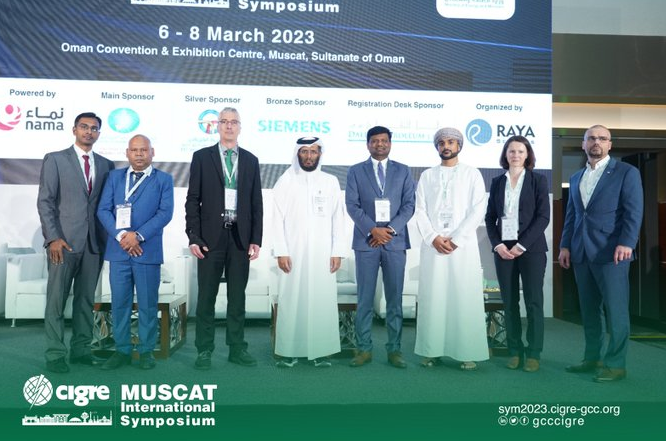
Presenters from Session A1
Study Committee B4 (DC Systems and Power Electronics)
CIGRE Study Committee (SC) B4 is responsible for the applications of DC and Power electronics in both transmission and distribution systems. The DC and FACTS markets are largely driven by the rapid growth of renewable energy and the requirements of a reliable and resilient power grid. SC B4 plays an important role in this process by providing a platform for the experts to share and exchange their thoughts and experiences.
A total of 8 papers were accepted based on the selected preferential subjects for the 2023 Muscat Symposium as listed below.
PS 1: Driving towards an enhanced system Sustainability, and Resiliency with increasing shares of Renewables (1 paper)
PS 3: Development in HVDC Grids and Multi-Terminal HVDC (7 papers)
These papers represented many aspects of HVDC application including:
- A novel grid forming control strategy in under weak system conditions
- Advantageous and more economic AC chopper applications for a HVDC system connected to weak or isolated AC grid.
- 25-year field experience of reactors in VSC HVDC systems
- Control strategy on the maximization of the usage of active and reactive power capacity of VSC converters
- Alternative MMC converters to provide better performance and cheaper cost
- Considerations of bulk power interregional and international HVDC transmission to achieve net-zero and to optimize the sharing of energy
- Experience with protection of DMR in a long distance HVDC transmission system
- A novel controllable line commutated converter based on parallel main/auxiliary semiconductors structured converters to minimize/eliminate the commutation failure in multi-infeed HVDC systems
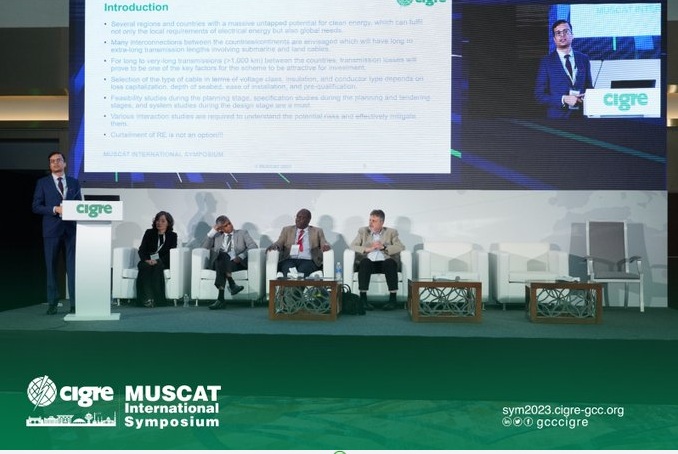
A presentation in progress in Session A2
Study Committee C6 (Active Distribution Systems and Distributed Energy Systems)
The Scope of SC C6 is to assess the technical impacts and requirements, which a more widespread adoption of Distributed Energy Resources (DER), together with a larger proportion of non-dispatchable power generation could impose on the planning and operation of distribution systems. In parallel, the SC also assesses enabling technologies and innovative solutions for DER integration in active distribution systems. Rural electrification, demand-side integration methodologies and the application of storage and electric vehicles as DER, are also within the scope of this SC.
12 papers were accepted, of which 4 were presented in session B2 on 07 March 2023, and 6 in session B3 on 08 March 2023 in relation to the following preferential subjects.
PS 1: Driving towards an enhanced system Sustainability, and Resiliency with increasing shares of Renewables (10 papers)
PS 3: Development in HVDC Grids and Multi-Terminal HVDC (2 papers)
These papers represented varied applications relating to DER integration and the use of innovative technologies. The key learnings from these papers were.
- The impact of DER integration on Grid Stability, and how innovative hybrid solutions and co-located convertor-based generators are touted as possible solutions.
- The optimization of PV+ BESS resources taking account of practical use case applications
- Innovative technology applications for DER uses.
- The importance of accurate data in the modelling outcomes of DER integration requirements and the consequent use of tools and systems for advanced analytic requirements.
- Cost impact studies relating to the least cost of energy approaches, whilst taking de-carbonization initiatives into account.
- Interest in MVDC applications for improved energy efficiency and reliability measures
- Greater understanding required with respect to the impact of Grid Forming Invertors and their application
The activities within SC C6 should thus build on the debates emanating from the 2022 Oman Symposium. The key impact will be the ability to learn from the lessons from across the globe, and to ensure that the collaboration within platforms such as CIGRE, enable such a transition towards an energy-secured future.

A presentation in progress in session B2
Summary comments from the remaining papers presented at the Symposium from the SC C2 and C5 related papers
- Large scale wide area protection system can enhance system resilience.
- With the growth of RES worldwide, it is very important to protect the network from interruptions by maintaining sufficient spinning reserve and ensuring sufficient system inertia to make accurate readings ahead of real-time operators.
- It is recommended that system operators perform inertial measurements to get an accurate, real-time view of inertia levels to replace guesswork and conservative estimates.
- Achieving a balance between economical energy choices and environmentally friendly power generation is one of the main goals of recent research in this area.
- Carrying out network-side simulation studies in the operational planning phase with hourly or sub-hourly resolution LGB is very computation and time-intensive.
- The regulatory incentives for private renewable projects should be considered in the transmission network access charge regime by creating asymmetric incentives for customers or it should take place via direct subsidization of renewable deployment.
